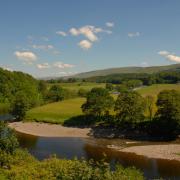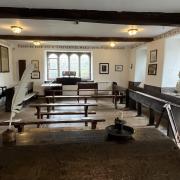The colours of spring may still be weeks away, but the arrival of snowdrops always provides a welcome seasonal lift in the darker days of winter. Poking through undergrowth, their clean, bright, nodding heads raise the spirits, little pearls of progress that signify nature’s shifting calendar.
This year, visitors are being invited to see them in all their glory at Acorn Bank, the National Trust property, near Penrith. The gardens are normally closed from the end of October until mid-March, but after a successful event last year once again the property is opening during each weekend in February from 11am-3pm on both Saturdays and Sundays.
Heather Birkett, garden and outdoor manager at Acorn Bank, explains: “The woodland at the back of the house is absolutely full of great swathes of snowdrops and we felt we were missing a trick by not being open.
“We tried it last year for the first time and it was very successful so once again people are invited to come and visit the woodlands and gardens and see the snowdrops.”

The vast majority of the plants are the straight species Galanthus nivalis, or common snowdrop, with some pockets of double flowered Galanthus nivalis ‘Flore Pleno’.
“We have so many that they couldn’t have been deliberately planted, although Galanthus isn’t native so they will have been introduced at some point. I know that a previous head gardener planted some,” says Heather. “Over time they have naturalised and spread because they are very happy in our climate. Last year we had a really cold spell in January and we were nervous that the snowdrops weren’t going to be out in time. They weren’t quite for the first weekend, but by the second weekend we had plenty. “
This winter has been mild so we’re confident they will be in full flower by February. “What makes them special here at Acorn Bank is that there are so many; it’s quite a spectacle behind the house and down the banks to Crowdundle Beck, both left and right, which are completely clothed in them. It’s the quantity of snowdrops that makes them special rather than the cultivars.”
During the open weekends the shop and courtyard café, which is run as a concession by Lakeland Coffee, will be open, along with Acorn Bank’s formal walled gardens which comprise a medicinal herb garden, herbaceous borders, lily-filled pond and traditional orchards carpeted with Edwardian daffodils in spring. “The garden isn’t showing as much interest at this time of year, but visitors are still welcome to walk around as well as going to the woodland,” adds Heather.

Acorn Bank, with its 180 acres of park and woodland, was given to the National Trust in 1950 by Dorothy Una Ratcliffe, the Yorkshire writer, traveller and art collector who had bought the property in 1934 with her second husband Captain Noel McGrigor Phillips.
Its first owners were the Knights Templar in 1228 then it passed to the Knights of the Hospital of St John, who held it from 1323 until the dissolution of the monasteries by King Henry VIII. In 1543 Acorn Bank was acquired by Thomas Dalston, a landowner from Dalston, near Carlisle, and remained in the hands of his descendants right up until the 1930s . Parts of the house date from the 16 th century, but the main block was rebuilt in the mid-17th century. It was given a new façade in the 1690s and Georgian sash windows were added in the 1740s .
During the late 1 8th and earl y 19th centuries it passed through the female line three times, eventually passing to the Boazman family , from County Durham, who started to mine gypsum at Acorn Bank from the 1880s onwards . The property was not their main residence and it had little investment ensuring that very few Victorian alterations were made

Dorothy Ratcliffe lived on at Acorn Bank with her third husband for a few years before relocating to Scotland. Her impressive collections of paintings, sculptures, glass and fans were bequeathed to the City of Leeds on her death in 1967.
Acorn Bank was leased to tenants for the next 40 years , latterly the Sue Ryder Foundation, which used it as a nursing home.
The garden, and later the estate walks, were opened to the public by the National Trust in the 1990s, when the restoration of the old watermill was also started. It is run by a dedicated team of volunteers who have restored its machinery to working order. Flour was ground for the first time in more than 70 years in September 2011. The volunteer team's achievement was recognised when it won the Marsh Heritage Volunteering Award in 2012 .
Acorn Bank attracted a record number of visitors in 2019 and in 2023 numbers were back up to 3 1, 000 for the year. “It was more than we expected because the cost of living crisis has had an impact,” says Heather.
Reflecting this, and the shorter opening hours in winter, admission at the property has been cut by 50 percent for the February weekends to £4.50 for adults, £2.25 for children or £ 1 1. 2 5 for a family ticket. National Trust members enjoy free entry.

The snowdrop woodland is a five-minute walk from the house and a walk along the surfaced paths through the woodland takes a minimum of 45 minutes. Those with limited mobility can still view the snowdrop banks, which are quite steep , from the accessible path.
Acorn Bank, Temple Sowerby, near Penrith, CA1 01SP nationaltrust.org.uk/visit/lake-district/acorn-bank



![The beaver and kit spotted at Lowther [Lowther-Estate]](/resources/images/128x89/1x/18601737.jpg)
![The beaver and kit spotted at Lowther [Lowther-Estate]](/resources/images/180x180/1x/18601737.jpg)


![Julie Carter [Jessie Leong]](/resources/images/128x89/1x/18534684.jpg)
![Julie Carter [Jessie Leong]](/resources/images/180x180/1x/18534684.jpg)


















